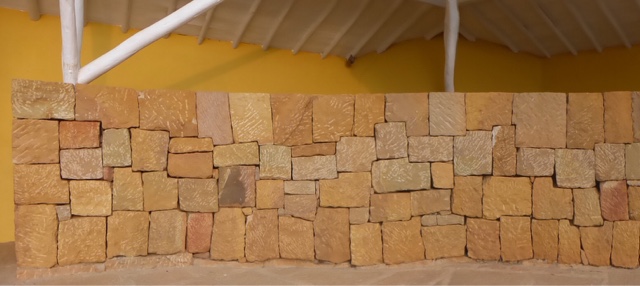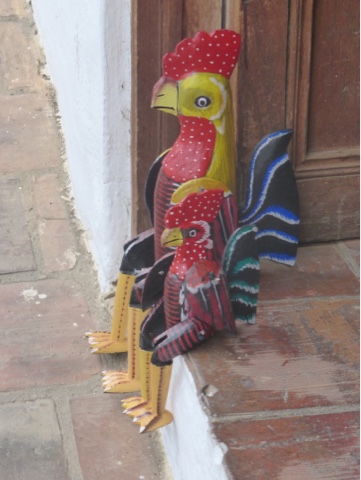Where next? Many travellers had recommended San Gil, the adventure capital of Colombia, where it's possible to go ziplining, white water rafting, bungee-jumping, bouldering, climbing etc etc but, nah... We decided to skip San Gil and go on to the nearby town of Barichara, which many consider to be the most picturesque town in all Colombia. I read that someone famous called it 'Colombia's loveliest' but I can't remember who now (Simon Bolivar?). That doesn't stop me using it for the title of this post!
So, a big bus from Mompox, with our travel-son, Sebastian, on the bumpy unmade road which stretches for miles before joining the highway, and with the grumpiest conductor in South America. We had numbered seats: 'ocho y nueve!' (8 & 9) he barked as we boarded the bus, then proceeded to sit in front of us and recline his seat as far as it would go and into Alan's lap. Buenas tardes to you, too, amigo. Sebastian did not escape, either. At 6' 4'', he had zero leg room and put his feet, without shoes, on the headrest of the empty seat in front. Grumpy McGrumpface, with eyes in the back of his head, bellowed at him to take them down. That would have been a bit more acceptable had the conductor himself not had his feet up, with his shoes on! Later, when Sebe made a bit of noise in his attempt to close the sticking toilet door after use he had another go. Whenever we met someone unreasonable or downright shitty, Sebe's mantra is'share the love', adding 'he'll die alone' which always makes us laugh and is a good approach to less than friendly people, which, we must say, are not plentiful in Colombia.
So, knackered, at 7pm, we reached Bucuramanga, a big, unattractive city, where we would stay the night before travelling on the next day. We checked into our hostel, another recommendation from a traveller, and which gets very good reviews on Tripadvisor and Hostelword, and which turned out to be horrible. Our room was scuzzy and had 2 windows, one onto the stairwell and the other onto the corridor, both noisy thoroughfares.
Artwork on the wall in our hostel room
We struggled to find somewhere open to eat that evening, a Friday, finally discovering Radio Burger which was jumping with young locals and served a very decent vegeburger.
Next morning, off to San Gil, where we would leave Sebastian and travel on to Barichara. The journey was spectacular.
Parque Nacional del Chicamocha from the bus to San Gil
.... From where we took the bus to Barichara, 17kms further on, with a pleasant climate and surrounded by beautiful countryside. It has only 10,000 inhabitants and has been declared a National Monument.
Just look at this place: gorgeous Barichara
This little town was so spectacularly photogenic we had to stop ourselves snapping all the time. Sorry if we've overdone it on this post!
The yellow-red earth is used for building everywhere in Barichara, creating a golden glow
Where in the world.....? Who would guess that this is Colombia?
Not a painting, but Items for sale in a little shop window
In the entrance of a hostel
Even the fire hydrants are pretty....
...and the moto ratons
Barichara, though picturebook beautiful, was not particularly friendly. We'd become used to people greeting us throughout Colombia, but our salutations were not returned for the most part. Our very reasonably priced hotel, an old house, with rooms arranged around an internal courtyard, was gorgeous and so stylish. We were the only guests for the whole of our 4 night stay and the staff were polite enough, but not friendly, unlike the two gentle giant dogs, Bruno and Mara.
Bruno and Mara watching the world go by
Courtyard of our hotel
I do love a hammock
These critters were for sale at the hotel
As were delicious home-made cakes and pastries....
Alan succumbing to temptation
Very elegant, rocks on strings
Our outdoor ensuite shower (cold water... Brrrr)
Sofa in our room
Just along the street from our hotel was a fantastic paper making workshop and shop.
Paper made from fique, cactus fibre, hanging up to dry
The cactus from which the paper is made
We bought just a tiny notebook - our moleskin is full
Lamps made from cactus fibre paper
The gorgeous workshop
Copper bins containing the soaking cactus fibre
Fique fibre, ready to be made into paper
The press
Storecupboard!
Images printed on the paper made at the workshop
These fun creatures are also made from cactus fibre paper
Inside the shop
I loved this paper workshop - did you guess?
Sebastian joined us in Barichara after just one night in San Gil - he hadnt' fancied any of the adventures on offer and they were quite expensive, too. Like us, he was stunned by the sheer beauty of Barichara. He joined us at our favourite little restaurant, Shanti, run by a very warm Argentinian woman who was a great cook.
Delicious mango ceviche for lunch in Shanti
This simple dish was piquant and unusual - ceviche is usually a fish dish, but here mango is given the lime treatment and is the recipe of this post:
Ingredients
- 1 large red onion, thinly sliced
- 2 large ripe mangoes, peeled and cut into 2cm pieces
- Juice of 4 limes
- 1/4 tsp salt
- 1 red chilli, seeded and finely chopped
- 1 tablespoon of coriander leaves, finely chopped
Method
- 1.
Put the red onion in iced water for 10 minutes while you prepare the other ingredients.
- 2.
Place the diced mangoes in a bowl and add half the lime juice and salt. Adjust if necessary, it should not taste too sour. Add the chilli, then drain the onion and add it along with the coriander leaves.
- 3.
Stir everything gently to combine and then leave in the fridge for 5 minutes to chill and marinate.
- 4.
Serve in individual large glasses or bowls.
Being vegetarian, we didn't sample the local delicacy, hormigas culones, literally big-assed ants. They are a type of leafcutter ant and it's the females which are eaten. They were sold in jars in many shops, also as a dish in restaurants. A local shopkeeper told us that they taste like peanuts, only more tasty. All the way from Mompox we had spotted huge anthills, like stalagmites, in the fields, but had been unable to take a photo as the bus was too fast and bumpy (plus we'd probably have been bawled out for standing up by the charming conductor!).
Sculptural homage to the big-ass ant in the local art park
And this metal one in our hotel courtyard
More sculptures in the art park
One day we and Sebastian hiked the 9km to Guane, the next village, along the Camino Real, an easy walk with stunning views.
View from the Camino Real
This woman passed us on the way, with a heavy load of firewood
Massive tree festooned with old man's beard, dwarfing Anna and even Sebastian

Peaceful and friendly Guane
Guane church
Little tourist bus
There are fossils everywhere in Guane (and Barichara). The village square has a centrepiece made entirely of fossils like this one:
Looks like a turtle?
Ambling along we came across a huge, very heavy tooth on the roadside:
Whose tooth was this?! Must have been pretty big - It measures about 8cm and is very heavy
Little red bird in the village square
Flame tree aflame in the village square
We'd picked up a leaflet advertising local workshops by craftsmen and women. Listed was a weaver who holds workshops in Guane. His work looked amazing, so we thought we'd try to find him while we were in the village. Easy. It's such a small, friendly place that the first person we asked knew where Nirko lived, so we picked our way down the stony lane to his house, passing this casita on the way:
We met Nirko, with a young woman, on the lane; we recognised him from his photo in the leaflet and, explaining why we were there, he explained that he was on his way to lunch, but he would love to talk with us for a while. The young woman was from Medellin and was taking part in a beginner's weaving workshop with Nirko. What a lovely, humble man. He was happy to chat and show us briefly around his little bamboo casita/workshop and invited us to return the next day when he'd have more time.
So, next day we took the bus to Guane and spent a happy hour or so talking textiles and wandering around his workshop and museum and sipping very tasty coffee together.
Loom in Nirko's workshop
Nirko's current piece of work
This is constructed on the same principle as a monkey finger trap. You stuff grated yucca into the mouth (above) until it's fat, pull from both ends and it squeezes it down, extracting the liquid from the yucca. Simple, but ingenious.
Peruvian pieces from Nirko's collection
Antique fique (cactus fibre) hammock trim
I (Anna) admired this beautiful piece of work, which was roughly covered with a piece of tarpaulin, but had been rained on. Nirko asked us to help him untie it, and, to my amazement and delight, he gave it to me as a gift. I didn't know what to say, except thank you, muchisimo gracias. What an honour.
So, onward and southward. We are so glad that we decided to spend more time in Colombia to see more of what this amazing country has to offer. It'll be difficult to leave and hard to beat.
Next post: Villa de Leyva, Boyacá










































































No comments:
Post a Comment
We enjoy reading your comments!